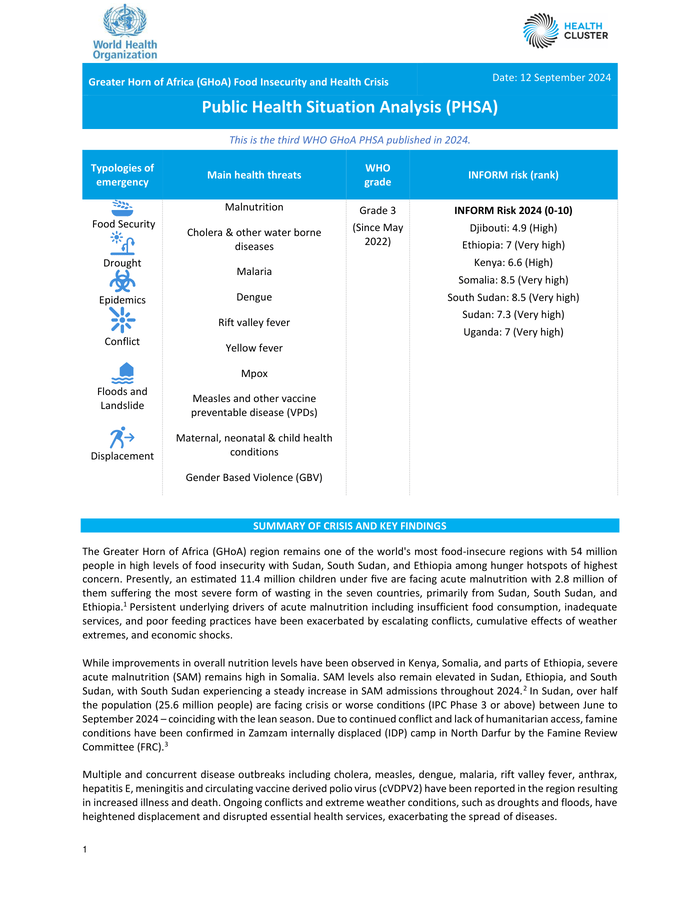Attachments
SUMMARY OF CRISIS AND KEY FINDINGS
The Greater Horn of Africa (GHoA) region remains one of the world’s most food-insecure regions with 54 million people in high levels of food insecurity with Sudan, South Sudan, and Ethiopia among hunger hotspots of highest concern. Presently, an estimated 11.4 million children under five are facing acute malnutrition with 2.8 million of them suffering the most severe form of wasting in the seven countries, primarily from Sudan, South Sudan, and Ethiopia. Persistent underlying drivers of acute malnutrition including insufficient food consumption, inadequate services, and poor feeding practices have been exacerbated by escalating conflicts, cumulative effects of weather extremes, and economic shocks.
While improvements in overall nutrition levels have been observed in Kenya, Somalia, and parts of Ethiopia, severe acute malnutrition (SAM) remains high in Somalia. SAM levels also remain elevated in Sudan, Ethiopia, and South Sudan, with South Sudan experiencing a steady increase in SAM admissions throughout 2024. In Sudan, over half the population (25.6 million people) are facing crisis or worse conditions (IPC Phase 3 or above) between June to September 2024 – coinciding with the lean season. Due to continued conflict and lack of humanitarian access, famine conditions have been confirmed in Zamzam internally displaced (IDP) camp in North Darfur by the Famine Review Committee (FRC).
Multiple and concurrent disease outbreaks including cholera, measles, dengue, malaria, rift valley fever, anthrax, hepatitis E, meningitis and circulating vaccine derived polio virus (cVDPV2) have been reported in the region resulting in increased illness and death. Ongoing conflicts and extreme weather conditions, such as droughts and floods, have heightened displacement and disrupted essential health services, exacerbating the spread of diseases.
The high prevalence of severe acute malnutrition (SAM) among children further increases their vulnerability to these diseases and raises the risk of mortality.
As of July 2024, the Greater Horn of Africa recorded its highest-ever number of forcibly displaced people, with approximately 26 million individuals, including 21 million internally displaced persons (IDPs) and 5 million refugees and asylum seekers. Of this total, 16 million have been displaced due to conflict, while 5 million have been displaced by natural disasters. Since the start of the conflict in the Sudan in April 2023, 10.7 million people (2.1 million families) have been internally displaced making it the world’s largest internal displacement crisis. Uganda, Ethiopia, and Sudan host the highest numbers of refugees in the region. Displacement is both a driver and consequence of food insecurity situation. Children and breast-feeding women are among the vulnerable population groups at risk of malnutrition and disease outbreaks as access to essential health services, water sanitation and hygiene services in the IDPs or refugee camps are limited. Moreover, protection risks are exacerbated due to displacement and inadequate access to basic facilities, increasing the risk of gender-based violence against women and girls.
The region is grappling with the impact of climate shocks and El Niño, oscillating between extremes, from a prolonged drought to floods. The historic four-year drought that hit East Africa has caused massive displacement and suffering. In 2024, heavy rains and flooding between March and May affected 1.6 million people across Eastern Africa. South Sudan and Sudan are currently experiencing severe flooding, worsened by the release of 2 600 cubic meters per second of water from a dam in Uganda, impacting over 789 000 people. This heavy rainfall and flooding have resulted in increased risk and surge of waterborne and vector borne diseases including a new cholera outbreak in Sudan and an upsurge of malaria in South Sudan.
This severe climate-induced shock comes against a backdrop of heightened vulnerability following the prolonged 2020-2023 drought and the floods during the June-December 2023 season. This was compounded by extensive flooding between November and December 2023, displacing more than four million people in the Horn of Africa. The heavy rains from March to May 2024 resulted in significant riverine floods, flash floods, landslides, and damage to dams across Kenya, Somalia, Ethiopia, and Uganda, with particularly severe impacts observed in Kenya. This has weakened communities’ coping capacity, making them highly susceptible to food insecurity, malnutrition and disease.
Outlook for the coming months
Between August and October 2024, wetter than usual conditions are expected over central to northern Ethiopia, South Sudan, Sudan, Uganda and parts of western Kenya. However, drier than usual conditions are expected over eastern parts of the region including western Ethiopia, and parts of north-western South Sudan.
The ongoing conflicts in Sudan, South Sudan, Ethiopia, and Somalia are likely to further exacerbate food insecurity, malnutrition crises and disease outbreak risks by driving displacement, disrupting health services and WASH infrastructure, causing shortages of food and non-food items (NFI), disrupting surveillance, and vector control efforts, and impeding humanitarian access and delivery of aid. This crisis coincides with the lean season and severe flooding in Sudan and South Sudan, which have already displaced hundreds of thousands and are expected to deteriorate further in the coming months.
Moreover, there is a 66 percent chance that a La Niña phenomenon will unfold between September – November 2024, bringing more rain to some regions and drought to others. In the past, such conditions were associated with drought in the eastern Horn of Africa. La Niña is expected to bring heavy rainfall to some areas, increasing the risk of flooding and the spread of waterborne diseases like cholera and vector-borne diseases such as malaria and dengue. Conversely, countries in the Horn of Africa anticipating dry conditions may face disruptions in essential health services (due to increased health care demand, displacement and lack of clean water and sanitation), higher rates of malnutrition, and increased risk of disease outbreaks, including vaccine preventable diseases.
This report covers several countries within the GHoA, including Djibouti, Ethiopia, Kenya, Somalia, South Sudan, Sudan, and Uganda.
Source link : https://reliefweb.int/report/sudan/greater-horn-africa-ghoa-food-insecurity-and-health-crisis-public-health-situation-analysis-phsa-12-september-2024
Author :
Publish date : 2024-09-12 07:00:00
Copyright for syndicated content belongs to the linked Source.
